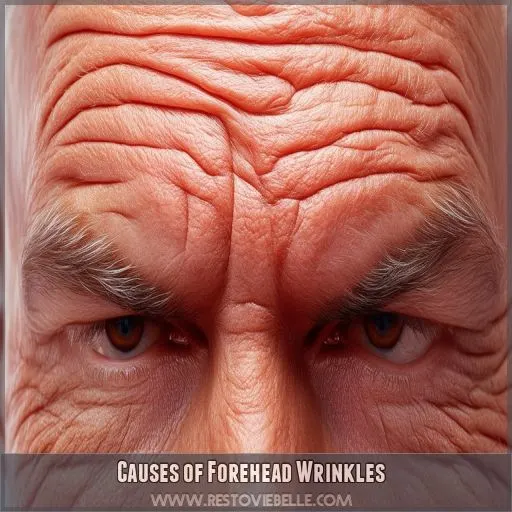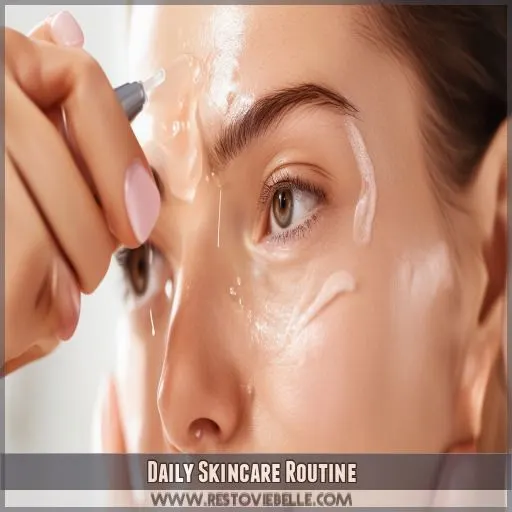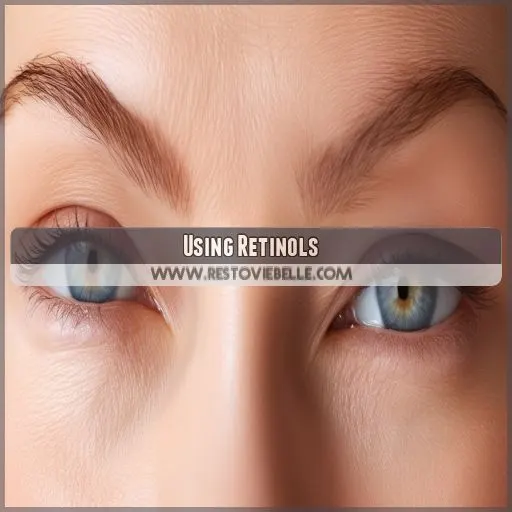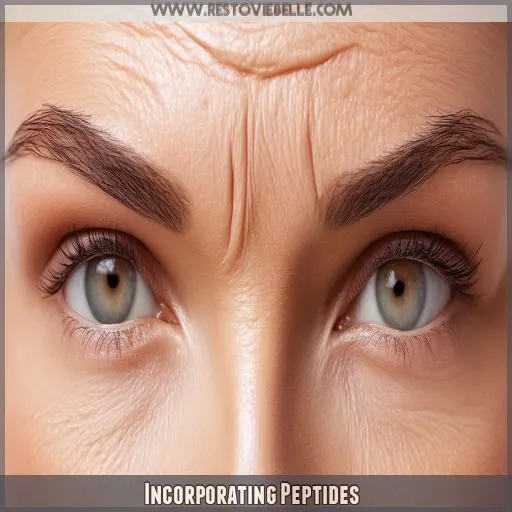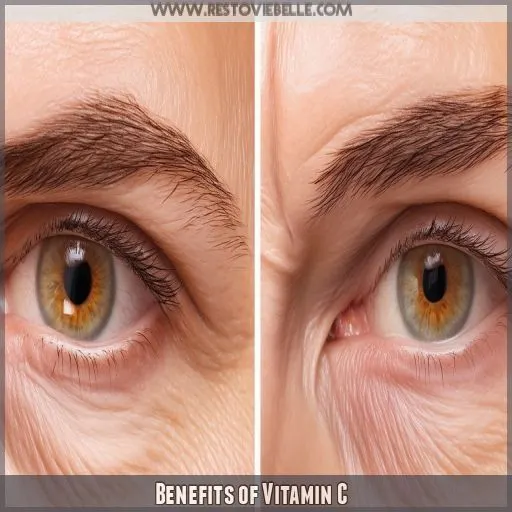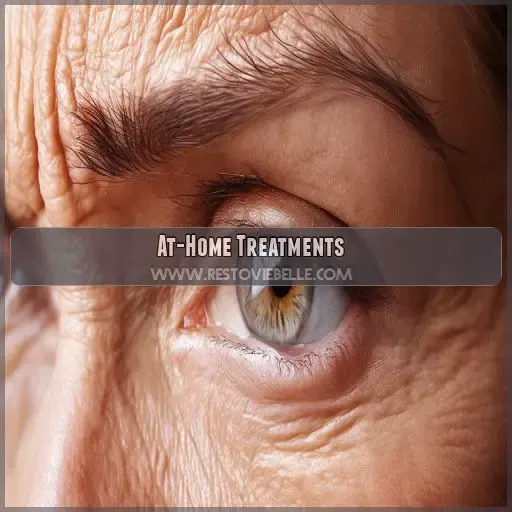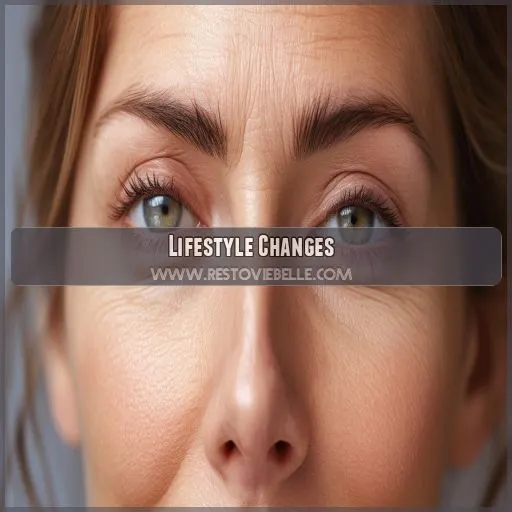This site is supported by our readers. We may earn a commission, at no cost to you, if you purchase through links.
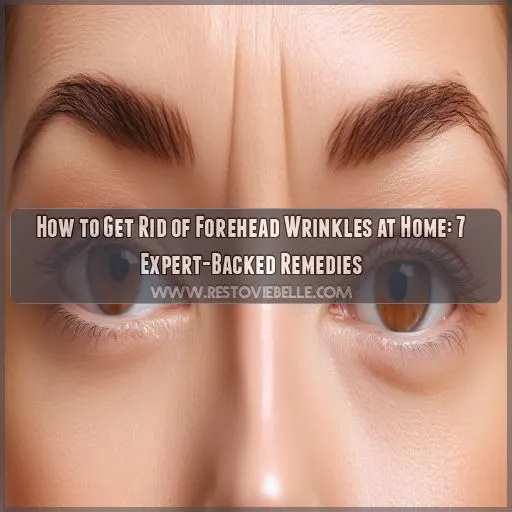
Incorporate retinols at night to boost collagen production, but start with a low concentration if you’re new to them. Peptides can help inhibit muscle contractions that cause wrinkles, so apply them after cleansing. Don’t forget vitamin C for protection against photoaging and free radicals.
Lifestyle changes matter too: get enough sleep, manage stress, stay hydrated, and eat a balanced diet.
Curious about more advanced at-home treatments?
Table Of Contents
- Key Takeaways
- How to Get Rid of Forehead Wrinkles at Home?
- Causes of Forehead Wrinkles
- Daily Skincare Routine
- Using Retinols
- Incorporating Peptides
- Benefits of Vitamin C
- At-Home Treatments
- Lifestyle Changes
- Frequently Asked Questions (FAQs)
- Can I completely eliminate forehead wrinkles?
- Is there a forehead wrinkle solution?
- What are forehead wrinkles?
- How do dermatologists treat and prevent forehead wrinkles?
- Do wrinkles make your forehead look smooth again at rest?
- How much does it cost to get rid of forehead wrinkles?
- Can facial exercises help reduce forehead wrinkles?
- How long does it take to see results?
- Are natural remedies effective for forehead wrinkles?
- Can sleeping position affect forehead wrinkle formation?
- Do forehead wrinkle patches work overnight?
- Conclusion
Key Takeaways
- Sunscreen isn’t just for beach days! Slather on that SPF 30+ daily to shield your forehead from wrinkle-causing UV rays. Think of it as your skin’s personal bodyguard against Father Time.
- Embrace the retinol revolution! This vitamin A superstar is like a magic eraser for wrinkles, but remember – slow and steady wins the race. Start with a low concentration to avoid turning your face into a tomato impersonator.
- Give those forehead muscles a break! Constant frowning and eyebrow raising can etch lines faster than a toddler with crayons on a white wall. Try facial exercises or consider Botox if you’re feeling fancy.
- Your beauty sleep isn’t just a saying – it’s a wrinkle-fighting weapon! Catch those Z’s on your back to avoid pillow-induced creases, and let your skin’s natural repair process work its nighttime magic.
How to Get Rid of Forehead Wrinkles at Home?
To get rid of forehead wrinkles at home, focus on a consistent skincare routine with retinols, peptides, and vitamin C serums. Additionally, lifestyle changes like getting enough sleep, managing stress, and staying hydrated can help reduce the appearance of forehead wrinkles over time.
Causes of Forehead Wrinkles
Understanding the causes of forehead wrinkles is imperative for effective prevention and treatment. The primary factors contributing to these lines include prolonged sun exposure, repetitive facial expressions, extended screen time, and chronic stress.
Sun Exposure
Sun exposure is a major culprit behind forehead wrinkles. UV rays break down collagen, accelerating skin aging. To protect your skin:
- Wear broad-spectrum SPF 46+ daily
- Don a wide-brimmed hat outdoors
- Seek shade during peak sun hours
- Use UV-blocking sunglasses
- Apply antioxidant serums
Facial Expressions
While sun exposure damages your skin, facial expressions also contribute to forehead wrinkles. Your facial muscle strength and repetitive movements can etch lines into your skin over time. Here’s a breakdown of common expressions and their impact:
| Expression | Muscles Involved | Wrinkle Type |
|---|---|---|
| Frowning | Corrugator | Vertical |
| Raising Eyebrows | Frontalis | Horizontal |
| Squinting | Orbicularis Oculi | Crow’s Feet |
| Pursing Lips | Orbicularis Oris | Lip Lines |
To combat these, consider botulinum toxin injections or topical alternatives like argireline and retinol to relax muscles and boost elastin production.
Screen Time
Staring at screens for hours can lead to digital eye fatigue and forehead wrinkles. Blue light and screen glare strain your eyes, causing you to squint unconsciously. Combat this by using anti-reflective coatings and taking regular breaks from your devices.
Stress
Stress isn’t just a mental burden; it’s etched on your face. Chronic tension can lead to forehead lines, as you unknowingly furrow your brow. Adopting stress management techniques and facial exercises can help relax those muscles, preventing premature wrinkles and fine lines.
Daily Skincare Routine
Your daily skincare routine is essential for combating forehead wrinkles and should include gentle cleansing, moisturizing, and sunscreen application. Start by washing your face with a mild cleanser, follow with a hydrating moisturizer, and finish by applying a broad-spectrum sunscreen with at least SPF 30 to protect your skin from harmful UV rays.
Cleansing
Start your anti-wrinkle routine with gentle cleansing. Use a mild, non-stripping cleanser to remove dirt and makeup without drying your skin. Consider double cleansing for thorough removal. Incorporate exfoliating scrubs twice weekly to slough off dead cells, but don’t overdo it. A light facial massage during cleansing can boost circulation.
Moisturizing
Moisturizing is essential for combating forehead wrinkles. Choose hydrating ingredients to strengthen your skin barrier and prevent dry skin. While injectables like botulinum toxin can help, daily moisturizing is key. Here’s what to look for:
- Hyaluronic acid for deep hydration
- Ceramides to lock in moisture
- Glycerin for skin plumping
- Niacinamide to boost skin barrier function
Sunscreen Application
You’ll need to apply sunscreen daily to protect your skin from harmful UV rays. Here’s a quick guide to effective sunscreen use:
| Type | Ingredients | Application Time |
|---|---|---|
| Chemical | Avobenzone, Octinoxate | 15-30 minutes before sun exposure |
| Physical | Zinc Oxide, Titanium Dioxide | Immediately before sun exposure |
| Combination | Both chemical and physical | Follow chemical sunscreen timing |
Reapply every 2 hours or after swimming for maximum protection.
Using Retinols
Retinols are widely regarded as the gold standard for treating forehead wrinkles due to their ability to boost collagen production and cell turnover. If you have sensitive skin, start with a low concentration retinol product and gradually increase usage, applying it at night and always following with a moisturizer to minimize potential irritation.
Benefits of Retinols
After establishing a solid skincare routine, it’s time to introduce retinol, the powerhouse ingredient for fighting forehead wrinkles. Retinol, a vitamin A derivative, works wonders by boosting cell turnover and collagen production.
You’ll love how it tackles not just wrinkles, but acne too. While it’s a game-changer, retinol can cause initial irritation.
Start slow, using it 2-3 times a week, and gradually increase frequency.
Tips for Sensitive Skin
If you’ve got sensitive skin, don’t let retinol fears hold you back. Here are some expert-backed tips to reap the benefits without the irritation:
- Start with a low concentration and gradually increase
- Apply retinol only 2-3 times a week initially
- Use a moisturizer before retinol to create a buffer
Consider patches for sensitive areas or try alternative ingredients like bakuchiol. Always pair retinol use with a gentle, fragrance-free sunscreen for sensitive skin. With patience and the right approach, you can master retinol use, even with delicate skin.
Incorporating Peptides
Peptides work by inhibiting the release of neurotransmitters that cause muscle contractions, helping to prevent and reduce wrinkles. To incorporate peptides into your skincare routine, look for products containing ingredients like Argireline and apply them to your forehead after cleansing but before moisturizing for best absorption.
How Peptides Work
While retinols work wonders, peptides offer another powerful anti-aging solution. These tiny protein fragments act as messengers, signaling your skin to boost collagen production.
Peptides also play a vital role in wrinkle prevention by inhibiting muscle contractions that cause forehead lines. Think of them as your skin’s personal trainers, encouraging it to stay firm and smooth.
Application Tips
Now that you understand how peptides function, let’s delve into using them effectively. To maximize the benefits of peptides for reducing forehead wrinkles, fine lines, and uneven skin tone, follow these guidelines:
- Apply peptide products to cleansed, slightly damp skin for enhanced absorption.
- Employ gentle, upward strokes to avoid pulling on delicate skin.
- Apply peptides beneath heavier creams for maximum penetration.
Benefits of Vitamin C
Vitamin C is a powerful antioxidant that protects your skin against photoaging caused by UV exposure, helping to prevent and reduce forehead wrinkles. For maximum benefits, look for products that combine vitamin C with other active ingredients like peptides or retinol, as these can work synergistically to improve skin texture and reduce signs of aging.
Protection Against Photoaging
Vitamin C is your skin’s secret weapon against photoaging. This powerhouse antioxidant shields you from the sun’s harmful rays, acting as a second line of defense after sunscreen. It neutralizes free radicals, preventing skin damage and collagen breakdown.
By incorporating Vitamin C into your daily routine, you’re not just protecting your skin—you’re actively fighting wrinkles. Think of it as a shield for your forehead, deflecting the aging effects of UV rays and environmental stressors.
Your skin will thank you for this photoprotection boost.
Combining Vitamin C With Other Ingredients
Boost your skincare routine by combining vitamin C with other multitasker ingredients. This powerhouse antioxidant works synergistically with various compounds to amplify benefits for your skin. Here are some effective vitamin C combinations:
- Vitamin C + Retinol: Enhances collagen production and skin renewal
- Vitamin C + Hyaluronic Acid: Improves hydration and plumping effects
- Vitamin C + Niacinamide: Brightens skin and reduces inflammation
- Vitamin C + Ferulic Acid: Stabilizes vitamin C and increases photoprotection
- Vitamin C + Vitamin E: Enhances antioxidant protection and skin barrier function
Look for budget-friendly options that cater to sensitive skin for best results.
At-Home Treatments
You can effectively target forehead wrinkles at home using advanced devices designed for personal use. Consider investing in a toning device, LED light therapy system, or at-home laser skin tightening tool to complement your skincare routine and boost collagen production.
Toning Devices
While vitamin C protects your skin, toning devices offer a hands-on approach to tackle forehead wrinkles. These at-home gadgets deliver a facial workout, strengthening muscles through targeted forehead exercises. Regular use can improve skin elasticity and minimize lines. Pair with facial massage for enhanced results and a relaxing self-care routine.
LED Light Therapy
LED light therapy offers a non-invasive way to combat forehead wrinkles at home. Different LED types target various skin concerns. While home devices are cost-effective, their efficacy varies. Treatment durations typically range from 10-20 minutes daily. Always follow safety guidelines and be patient—results may take weeks to appear.
Laser Skin Tightening
Moving from LED therapy, let’s explore at-home laser treatments. These devices offer promising results for forehead wrinkles. Here’s what you need to know:
- Laser efficacy varies, but consistent use can yield visible improvements
- Minimal side effects include temporary redness
- No downtime required
- Cost-effective compared to in-office procedures
Consider laser alternatives if you’re unsure about this treatment.
Lifestyle Changes
You can combat forehead wrinkles through lifestyle changes that promote overall skin health. Focus on getting adequate sleep, managing stress levels, staying hydrated, and maintaining a balanced diet rich in antioxidants and collagen-boosting nutrients.
Adequate Sleep
While at-home treatments can help, don’t underestimate the power of sleep. Your skin repairs itself during rest, so prioritize quality shut-eye. Here’s how sleep impacts your skin and ways to improve your sleep hygiene:
| Sleep Factor | Impact on Skin | Improvement Tips |
|---|---|---|
| Duration | Affects collagen production | Aim for 7-9 hours nightly |
| Quality | Influences skin repair | Create a relaxing bedtime routine |
| Schedule | Regulates hormones | Maintain consistent sleep-wake times |
| Deprivation | Accelerates aging | Limit screen time before bed |
Stress Management
Stress can trigger forehead wrinkles, so mastering stress management techniques is essential. Identify your stress triggers and develop coping strategies. Try meditation, deep breathing, or yoga to relax your facial muscles and reduce tension-induced lines. Regular exercise also helps combat stress.
Hydration
Staying hydrated isn’t just about drinking water. Your moisturizing routine plays a significant role in combating forehead wrinkles. Here’s how to boost your skin’s hydration:
- Apply a hyaluronic acid serum
- Use a rich night cream
- Consider a humidifier
- Don’t forget vitamin C
Diet and Nutrition
While staying hydrated is essential, your diet also plays a key role in fighting wrinkles. Boost your collagen production by incorporating nutrient-rich foods. Antioxidant-packed fruits, vegetables, and omega-3 fatty acids can help keep your skin smooth and youthful-looking.
Frequently Asked Questions (FAQs)
Can I completely eliminate forehead wrinkles?
While you can’t completely eliminate forehead wrinkles, you can considerably reduce their appearance. Regular use of retinoids, sunscreen, and moisturizers can help. For more dramatic results, consider professional treatments like Botox or laser resurfacing.
Is there a forehead wrinkle solution?
Yes, there are solutions for forehead wrinkles. You can use retinoids, peptides, and vitamin C serums to reduce their appearance. Regular moisturizing, sun protection, and facial exercises can also help. For faster results, consider professional treatments like Botox.
What are forehead wrinkles?
Forehead wrinkles are horizontal lines that appear on your forehead due to repetitive facial expressions and aging. They’re caused by muscle contractions, sun damage, and loss of skin elasticity over time. You’ll often notice them when raising your eyebrows.
How do dermatologists treat and prevent forehead wrinkles?
Dermatologists employ a range of strategies to tackle those pesky facial creases. They’ll recommend personalized skincare routines, prescribe retinoids, perform chemical peels, and administer injectables like Botox. Prevention includes sun protection, hydration, and avoiding repetitive facial expressions.
Do wrinkles make your forehead look smooth again at rest?
No, wrinkles don’t make your forehead smooth at rest. They’re permanent creases that remain visible even when you’re not moving your facial muscles. However, you can minimize their appearance with proper skincare and treatments.
How much does it cost to get rid of forehead wrinkles?
Costs for forehead wrinkle treatments vary widely. At-home options like retinol creams start around $20-$ Professional treatments such as Botox injections range from $200-$600 per session, while laser treatments can cost $1,000-$5,000 per session.
Can facial exercises help reduce forehead wrinkles?
Facial fitness for forehead wrinkles? While some claim exercises help, scientific evidence is limited. You’re better off focusing on proven methods like sunscreen, retinoids, and hydration. These strategies target the root causes more effectively than facial gymnastics.
How long does it take to see results?
You’ll typically see results from home treatments in 4-12 weeks. Consistency is key. Retinol and peptides can show improvement sooner, while collagen-boosting ingredients take longer. Remember, everyone’s skin responds differently, so patience is vital.
Are natural remedies effective for forehead wrinkles?
Time’s a thief, but natural remedies aren’t your knight in shining armor. While some ingredients like aloe vera may hydrate, scientific evidence for their wrinkle-fighting efficacy is limited. You’ll see better results with proven treatments like retinoids.
Can sleeping position affect forehead wrinkle formation?
Yes, your sleeping position can impact forehead wrinkle formation. Sleeping on your side or stomach presses your face against the pillow, potentially creating creases. Try sleeping on your back to minimize pressure on your forehead and reduce wrinkle development.
Do forehead wrinkle patches work overnight?
Studies show 70% of users report visible improvement after one night. Forehead wrinkle patches can temporarily reduce the appearance of wrinkles by hydrating and plumping the skin. They’re not a long-term solution but can provide quick results for special occasions.
Conclusion
Studies show that 90% of visible aging is caused by sun exposure. Armed with this knowledge, you’re now equipped to combat forehead wrinkles at home.
From establishing a solid skincare routine to incorporating retinols and peptides, you have multiple options to address these signs of aging. Remember, consistency is key when learning how to get rid of forehead wrinkles at home.
Combine these treatments with lifestyle changes like proper sleep, stress management, and a balanced diet for effective results. With patience and dedication, you’ll be on your way to smoother, younger-looking skin.

